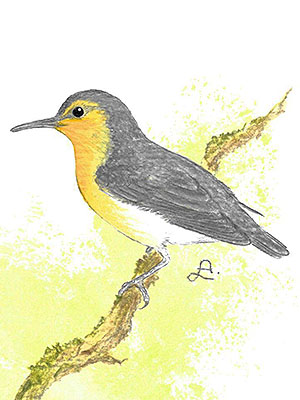This was posted on David Peters’ website on June 6, 2018.:
“Pumiliornis tesellatus [sic] is a wren-sized (shown larger than actual size) Messel pit bird that was originally (Mayr 1999) considered an enigma and later (Mayr 2008) allied with cuckoos. In the large reptile tree (LRT, 1225 taxa) tiny Pumiliornis nests with Platalea, the spoonbill (Fig. 2) as a phylogenetic miniature, close to, but not quite related to the parallel, short-legged genesis of ducks and geese.”
I’m not quite sure what this “short-legged genesis” is supposed to be, but the length of the legs does not indicate any relationships between birds but has much more to do with their way of life!
“Presbyornis, currently at the base of ducks, still has long legs and a long neck. More derived taxa in the duck branch lose their long legs, although some, like the swan and goose, retain a long neck.”
What does that have to do with the genus Pumiliornis or with spoonbills?
“Pumiliornis tessellatus (Mayr 1999, 2008; 6cm long; middle Eocene). This wren-sized relative to spoonbills and ancestor to ducks has a spatulate beak tip. This is a neotonous [sic] form of the long-legged spoonbill with juvenile size and proporitons [sic] representing the genesis of a new clade. This fossil contains fossil grains in the cloacal area (white box). Note that no webbing is preserved between the toes. Spoonbills also lack webbed toes.”
***
No, it is not a relative of the spoonbills, and it is not at all an ancestor to ducks, which by the way already existed anyway back then, which again would make it even harder to be their ancestor ….
No, its beak tip isn’t spathulate ….
Yep, Pumiliornis was a very small bird – that doesn’t make it neotenous, at least not more so than any other Passeriform bird, which are indeed thought of as being somewhat neotenous compared to non-passeriform birds.
No, its proportions are not those of a juvenile spoonbill ….
Yep, the fossil contains fossil grains – pollen grains, since it obviously was a nectar-feeding bird with an elongated beak as is typical for nectar-feeding birds ….
No, Spoonbills do not lack webbing on their toes, they actually have small webs along the bases of their toes ….
***
To think that a small nectar-feeding perching bird is the ancestor of ducks and a relative of spoonbills is, well, funny. To promote that bullshit as if it would be the absolute truth, however, is just insane!
***
I’ll probably take some of my precious time to try to debunk more of David Peter’s nonsense in the future, we’ll see.
***
Why the world really should ignore David Peters
*********************
edited: 30.07.2021


